Enneacontahexagon
| Regular enneacontahexagon | |
|---|---|
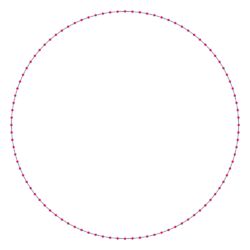 A regular enneacontahexagon | |
| Type | Regular polygon |
| Edges and vertices | 96 |
| Schläfli symbol | {96}, t{48}, tt{24}, ttt{12}, tttt{6}, ttttt{3} |
| Coxeter diagram | |
| Symmetry group | Dihedral (D96), order 2×96 |
| Internal angle (degrees) | 176.25° |
| Dual polygon | Self |
| Properties | Convex, cyclic, equilateral, isogonal, isotoxal |
In geometry, an enneacontahexagon or enneacontakaihexagon or 96-gon is a ninety-six-sided polygon. The sum of any enneacontahexagon's interior angles is 16920 degrees.
Regular enneacontahexagon
The regular enneacontahexagon is represented by Schläfli symbol {96} and can also be constructed as a truncated tetracontaoctagon, t{48}, or a twice-truncated icositetragon, tt{24}, or a thrice-truncated dodecagon, ttt{12}, or a fourfold-truncated hexagon, tttt{6}, or a fivefold-truncated triangle, ttttt{3}.
One interior angle in a regular enneacontahexagon is 1761⁄4°, meaning that one exterior angle would be 33⁄4°.
The area of a regular enneacontahexagon is: (with t = edge length)
- [math]\displaystyle{ \begin{align} A = &24t^2 \cot \frac{\pi}{96}\\ = &24t^2 \left(2+ \sqrt{3} + \sqrt{2} + \sqrt{6} + \sqrt{ 16+8 \sqrt{3} +2 \sqrt{ 104+60 \sqrt{3} } } +\sqrt{ 32+ 16\sqrt{3} +4 \sqrt{ 104+60 \sqrt{3} } +2 \sqrt{ 848+488 \sqrt{3} +2(31+16\sqrt{3}) \sqrt{ 104+60 \sqrt{3} } } }\right) \\ = &24t^2 \left(2+ \sqrt{3} + \sqrt{2} + \sqrt{6} + \sqrt{ 16+8 \sqrt{3} +2 \sqrt{ 104+60 \sqrt{3} } } +\sqrt{ 32+ 16\sqrt{3} +4 \sqrt{ 104+60 \sqrt{3} } +2 \sqrt{ 848+488 \sqrt{3} +2\sqrt{ 358376+206908 \sqrt{3} } } }\right) .\end{align} }[/math]
The enneacontahexagon appeared in Archimedes' polygon approximation of pi, along with the hexagon (6-gon), dodecagon (12-gon), icositetragon (24-gon), and tetracontaoctagon (48-gon).
Construction
Since 96 = 25 × 3, a regular enneacontahexagon is constructible using a compass and straightedge.[1] As a truncated tetracontaoctagon, it can be constructed by an edge-bisection of a regular tetracontaoctagon.
Symmetry
The regular enneacontahexagon has Dih96 symmetry, order 192. There are 11 subgroup dihedral symmetries: (Dih48, Dih24, Dih12, Dih6, Dih3), (Dih32, Dih16, Dih8, Dih4, Dih2 and Dih1), and 12 cyclic group symmetries: (Z96, Z48, Z24, Z12, Z6, Z3), (Z32, Z16, Z8, Z4, Z2, and Z1).
These 24 symmetries can be seen in 34 distinct symmetries on the enneacontahexagon. John Conway labels these by a letter and group order.[2] The full symmetry of the regular form is r192 and no symmetry is labeled a1. The dihedral symmetries are divided depending on whether they pass through vertices (d for diagonal) or edges (p for perpendiculars), and i when reflection lines path through both edges and vertices. Cyclic symmetries in the middle column are labeled as g for their central gyration orders.
Each subgroup symmetry allows one or more degrees of freedom for irregular forms. Only the g96 subgroup has no degrees of freedom but can seen as directed edges.
Dissection
Coxeter states that every zonogon (a 2m-gon whose opposite sides are parallel and of equal length) can be dissected into m(m-1)/2 parallelograms.[3] In particular this is true for regular polygons with evenly many sides, in which case the parallelograms are all rhombi. For the regular enneacontahexagon, m=48, and it can be divided into 1128: 24 squares and 23 sets of 48 rhombs. This decomposition is based on a Petrie polygon projection of a 48-cube.
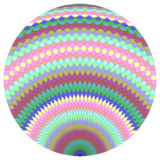
|
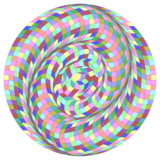
|
Enneacontahexagram
An enneacontahexagram is a 96-sided star polygon. There are 15 regular forms given by Schläfli symbols {96/5}, {96/7}, {96/11}, {96/13}, {96/17}, {96/19}, {96/23}, {96/25}, {96/29}, {96/31}, {96/35}, {96/37}, {96/41}, {96/43}, and {96/47}, as well as 32 compound star figures with the same vertex configuration.
| Picture | 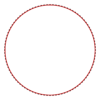 {96/5} |
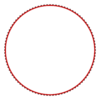 {96/7} |
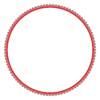 {96/11} |
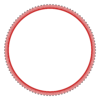 {96/13} |
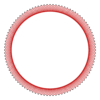 {96/17} |
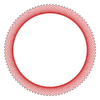 {96/19} |
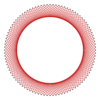 {96/23} |
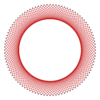 {96/25} |
|---|---|---|---|---|---|---|---|---|
| Interior angle | 161.25° | 153.75° | 138.75° | 131.25° | 116.25° | 108.75° | 93.75° | 86.25° |
| Picture |  {96/29} |
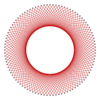 {96/31} |
 {96/35} |
 {96/37} |
 {96/41} |
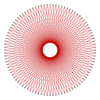 {96/43} |
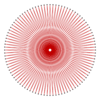 {96/47} |
|
| Interior angle | 71.25° | 63.75° | 48.75° | 41.25° | 26.25° | 18.75° | 3.75° |
References
- ↑ Constructible Polygon
- ↑ John H. Conway, Heidi Burgiel, Chaim Goodman-Strauss, (2008) The Symmetries of Things, ISBN:978-1-56881-220-5 (Chapter 20, Generalized Schaefli symbols, Types of symmetry of a polygon pp. 275-278)
- ↑ Coxeter, Mathematical recreations and Essays, Thirteenth edition, p.141


